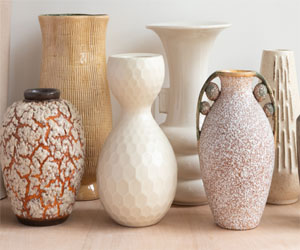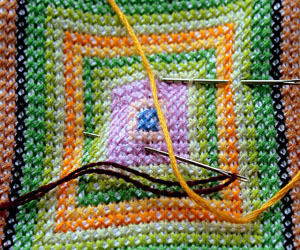


The Fusion Of Tradition And Innovation

Ceramics, an art form with a history dating back millennia, has taken on new life in the contemporary art world. Contemporary ceramics represent a dynamic fusion of traditional techniques and innovative ideas, resulting in a breathtaking array of artistic expressions. This revitalized craft has garnered international attention and a dedicated following among artists and collectors.
Breaking Boundaries: Contemporary ceramics are marked by a fearless embrace of experimentation. Artists working in this medium are unafraid to push the boundaries of traditional ceramics, often combining clay with other materials such as metals, glass, or textiles. The use of digital technology has enabled artists to design intricate patterns and precise shapes, opening up entirely new possibilities.
Diverse Styles And Themes: One of the most exciting aspects of contemporary ceramics is the diversity of styles and themes explored by artists. From minimalist and functional pottery to abstract and conceptual sculptures, contemporary ceramics encompass a wide range of artistic expressions. Some artists delve into social and political commentary, while others focus on the beauty of the natural world. This diversity reflects the vast creative potential of ceramics in the hands of contemporary artists.
Cross-Cultural Influences: Contemporary ceramics draw inspiration from a global palette. Artists often blend influences from various cultures and traditions, leading to cross-cultural dialogues through their work. Whether it's the fusion of Asian and Western aesthetics or the exploration of indigenous techniques, contemporary ceramics are a testament to the interconnectedness of art across borders.
Sustainability And Eco-Consciousness: In recent years, contemporary ceramics have also embraced sustainability. Many artists are turning to eco-friendly materials, firing processes, and glazes to minimize the environmental impact of their work. Ceramics, with its inherent durability, has become a symbol of sustainability in the art world. Some artists even repurpose and recycle materials, transforming them into ceramic art.
Collaboration And Innovation: The collaborative nature of contemporary ceramics has led to exciting innovations. Artists often work with scientists, engineers, and other artisans to create groundbreaking pieces. For instance, 3D-printed ceramics and advancements in kiln technology have expanded the possibilities for artists, allowing for precise, complex, and large-scale creations that were once unimaginable.
Collectors' Fascination: Collectors have become increasingly drawn to contemporary ceramics, recognizing the uniqueness and investment potential of these pieces. Renowned ceramic artists' works are sought after in the art market, often fetching substantial prices at auctions and galleries. This growing interest among collectors further cements the significance of contemporary ceramics in the art world.
Global Recognition: Contemporary ceramics have earned a place in prestigious museums and galleries worldwide. Prominent institutions have dedicated exhibitions and collections to showcase the best of contemporary ceramic art. This recognition highlights the enduring appeal and artistic significance of ceramics in the modern era.
Contemporary ceramics are a testament to the enduring allure of this ancient art form. By breaking free from traditional constraints, artists have rejuvenated ceramics, fostering an environment of boundless creativity. From artistic expression to social commentary and sustainability, contemporary ceramics encapsulate the essence of our ever-evolving world. As artists continue to explore the limitless potential of clay and fire, contemporary ceramics will remain at the forefront of the art world, capturing the imagination and admiration of art enthusiasts and collectors alike.
Crafting Beauty From The Ordinary
 Melding Form And Function: Woodworking blends form and function seamlessly. It's not just about creating a beautiful object; it's about making something that is also practical and useful. Furniture, for instance, should be comfortable and functional, while also serving as a stunning piece of decor. Woodworkers carefully consider the design, shape, and functionality of their creations, ensuring they harmonize with the artistic vision.
Melding Form And Function: Woodworking blends form and function seamlessly. It's not just about creating a beautiful object; it's about making something that is also practical and useful. Furniture, for instance, should be comfortable and functional, while also serving as a stunning piece of decor. Woodworkers carefully consider the design, shape, and functionality of their creations, ensuring they harmonize with the artistic vision.
Attention To Detail: One of the hallmarks of transforming lumber into art is the unwavering attention to detail. Woodworkers invest time and precision in every aspect of the project. From selecting the right joinery techniques to meticulously sanding and finishing, no detail is too small to be overlooked. This dedication results in a level of craftsmanship that elevates a simple piece of lumber into a masterpiece.
Creativity Unleashed: Woodworking is not confined by traditional boundaries. It encourages innovation and creativity. A piece of lumber can become a unique sculpture, an intricately designed carving, or a functional object of beauty. Woodworkers draw inspiration from a myriad of sources, and their creativity knows no bounds. The result is a diverse world of wooden art, where imagination is the only limit.
Respecting The Grain: The grain of the wood is the artist's guide, and it's essential to respect it. Woodworkers work with the grain, allowing it to dictate the direction of the project. This harmonious collaboration between artist and material ensures that the final creation is in harmony with nature. The grain becomes an integral part of the art, enhancing its character and allure.
A Labor Of Love: Transforming lumber into art is not merely a job; it's a labor of love. Woodworkers pour their hearts and souls into their projects, investing time, effort, and dedication.
The Magical Transformation Behind The Brew
 The Fermentation Process: Fermentation begins when the wort (unfermented beer) is transferred to a fermentation vessel, and yeast is introduced. The yeast starts consuming the sugars, breaking them down into alcohol, carbon dioxide, and a range of flavor compounds. During this process, the temperature and oxygen levels are carefully controlled to achieve the desired characteristics for the beer style.
The Fermentation Process: Fermentation begins when the wort (unfermented beer) is transferred to a fermentation vessel, and yeast is introduced. The yeast starts consuming the sugars, breaking them down into alcohol, carbon dioxide, and a range of flavor compounds. During this process, the temperature and oxygen levels are carefully controlled to achieve the desired characteristics for the beer style.
Primary And Secondary Fermentation: The initial fermentation, called primary fermentation, typically lasts one to two weeks. Afterward, some beer styles may undergo a secondary fermentation or conditioning phase. In secondary fermentation, the beer may be transferred to a different vessel, such as a secondary fermenter or barrels, to develop further flavors and clarity.
Flavor Development: The fermentation process is where the beer's flavor is largely determined. Yeast produces a wide variety of compounds, including alcohols, esters, and phenols, which contribute to the aroma and taste of the beer. For example, esters can impart fruity notes like banana or apple, while phenols may introduce subtle smoky or spicy characteristics.
Alcohol Production: The yeast's primary job is to convert sugars into alcohol. Ethanol, the type of alcohol found in beer, is the result of this process. The level of alcohol in the final beer depends on factors such as the type and amount of malt used and the yeast's alcohol tolerance.
Carbonation: In addition to alcohol, fermentation produces carbon dioxide, which is the source of beer's effervescence. The carbonation level can be controlled by varying factors like yeast strain, fermentation temperature, and pressure during packaging.
A Green Revolution In Beauty
 Clean Beauty: One of the core principles of plant-based cosmetics is their commitment to clean beauty. They avoid harmful chemicals, synthetic fragrances, and toxic additives found in traditional cosmetics. This reduces the risk of skin sensitivities, allergies, and long-term health issues.
Clean Beauty: One of the core principles of plant-based cosmetics is their commitment to clean beauty. They avoid harmful chemicals, synthetic fragrances, and toxic additives found in traditional cosmetics. This reduces the risk of skin sensitivities, allergies, and long-term health issues.
Sustainability In Practice: Many plant-based cosmetics brands prioritize sustainable practices. They responsibly source their ingredients, employ eco-friendly manufacturing methods, and package their products in recyclable or biodegradable materials. This substantially reduces their ecological footprint.
Cruelty-Free Commitment: A significant portion of plant-based cosmetics is cruelty-free, meaning they do not engage in animal testing. This aligns with the principles of compassionate consumerism and ethical treatment of animals.
Transparency And Accountability: Transparency is a hallmark of plant-based cosmetics brands. They provide clear and detailed information about their ingredients, sourcing, and production processes. This empowers consumers to make informed choices about the products they apply to their skin.
Broad Range Of Products: Plant-based cosmetics extend beyond skincare to include makeup products like foundations, lipsticks, and eyeshadows. These clean cosmetics provide safe and effective alternatives for enhancing beauty without compromise.
Holistic Beauty Philosophy: Plant-based cosmetics encourage a holistic approach to beauty, emphasizing the connection between external well-being and inner harmony. They advocate self-care, mental wellness, and self-confidence.
Needle And Thread
 The Thread's Transformative Power: Thread, on the other hand, is a slender strand of material that comes in numerous forms, including cotton, silk, wool, and synthetic fibers. Its primary function is to connect, bind, and adorn. When combined with the needle, thread takes on the role of an artist's brush, creating intricate designs, securing seams, and adding decorative elements to fabrics. The choice of thread can dramatically impact the final outcome, from the sheen of silk to the durability of polyester.
The Thread's Transformative Power: Thread, on the other hand, is a slender strand of material that comes in numerous forms, including cotton, silk, wool, and synthetic fibers. Its primary function is to connect, bind, and adorn. When combined with the needle, thread takes on the role of an artist's brush, creating intricate designs, securing seams, and adding decorative elements to fabrics. The choice of thread can dramatically impact the final outcome, from the sheen of silk to the durability of polyester.
Sewing And Fabric Mending: At its core, the needle and thread serve the practical purpose of sewing and mending fabric. From fixing a torn hem to attaching buttons, these tools are essential for extending the lifespan of clothing and textiles. This ability to repair and restore not only saves money but also contributes to sustainable and eco-friendly practices by reducing waste.
Embroidery And Artistry: One of the most celebrated applications of the needle and thread is in the realm of embroidery. This art form involves the use of different stitches and thread colors to create intricate and beautiful designs on fabric. It has been used for centuries to embellish clothing, linens, and decorative items, adding a touch of elegance and personalization to everyday objects.
Cultural And Traditional Significance: Needlework, often passed down through generations, carries cultural and traditional significance in many societies. It can tell stories, showcase regional motifs, and connect individuals to their heritage. Each culture has its unique stitching techniques and designs, making the needle and thread a powerful tool for cultural preservation.
Creative Candle Making Ideas
 Flower-Embedded Candles: Press dried flowers or herbs between sheets of wax to create stunning, botanical candles. Whether you choose vibrant petals or aromatic herbs, these candles bring a touch of nature into your home.
Flower-Embedded Candles: Press dried flowers or herbs between sheets of wax to create stunning, botanical candles. Whether you choose vibrant petals or aromatic herbs, these candles bring a touch of nature into your home.
Ice Candle Art: Ice candles are a fascinating and innovative approach to candle making. Freeze wax around a pre-made mold filled with ice, and as the ice melts, it creates intriguing patterns in the candle. The end result is a truly one-of-a-kind piece.
Hidden Treasure Candles: Embed small, non-flammable objects like charms, gemstones, or small messages within your candles. As the wax melts, these hidden treasures are revealed, adding an element of surprise to your candle making.





